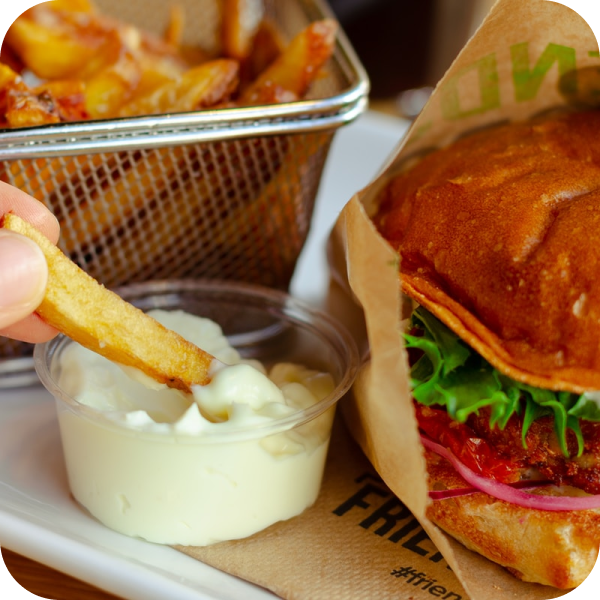9,2
/10
customer satisfaction

In my previous blog I wrote about the 10 best meals of 2021, looking at the logged Clear data. Our participants log their meals and we assess them on their blood sugar patterns. If you keep your blood sugar stable, you prevent the risk of an energy dip. A stable blood sugar level is also very important when you have prediabetes or type 2 diabetes. This prevents the condition from getting worse and you need more medication. In this blog you can read which meals are bad for blood sugar levels and how you can improve them.
We assess the meals based on the Clear Food Score. A Food Score above 70 is good: your blood sugar levels do not rise so quickly after a meal for you personally. Below 70 there is room for improvement. The lower your Food Score, the worse!
Although the meals provide a strong peak, they are enjoyed by many. That is why I give a number of tips on how you can improve these meals, so that there is a greater chance that such a meal will work out well for you. Do you want to know for sure how you score on a dish? Then start with Clear!
1. Pizza (average Food Score: 5)
This ‘bad’ dish hits many people hard. Due to the large amount of carbohydrates and the lack of fiber (pizzas usually do not contain 250 grams of vegetables), you can easily peak on a pizza. Can I never eat pizza again? Fortunately, at Clear we have good alternatives. If you don’t want to change anything about the pizza itself, an alternative would be to adjust the portion size. Most participants eat too much: a whole pizza puts a heavy burden on your glucose balance. Many pizzas base the nutritional value on one serving: that is often half a pizza. Do you usually eat a whole pizza? Try half a pizza once and complete your dinner with a green salad or soup as a starter. You can also opt for a cauliflower pizza base or make your own.
2. Couscous (average Food Score: 5)
Couscous is tasty, versatile and can be on the table in no time. This often leads to a blood sugar spike. Portion size also plays a role here: a standard serving is 75 grams and many eat more than one serving. Also note that not all couscous varieties are made of whole wheat grains. The whole grain version contains more fiber than the standard version. Fiber ensures that sugars are absorbed more slowly. Make an extra healthy version by adding healthy fats and fibers, such as fish and (leaf) vegetables. Or try couscous made from cauliflower. Sometimes raisins are added to the couscous: they are rich in sugars. For example, replace these with pomegranate seeds. Here you will find a delicious recipe for couscous with fresh spinach, haddock and pomegranate seeds.
3. Roti (average Food Score: 10)
From the Moroccan kitchen we go full steam ahead to the Surinamese kitchen. Roti is eaten less often than couscous, but is still a popular dish among the Clear participants. How come people peak on roti? Roti consists of roti wraps (high in carbohydrates) and often contains potato. Potatoes also have a high glycemic index (this indicates how quickly carbohydrates are absorbed into the blood). Therefore, consider omitting the potato and adding extra vegetables. For example, instead of a roti wrap, you can use a low-carb Atkins wrap.
4. Fruit salad (average Food Score: 10)
A fruit salad is packed with vitamins. Most fruits contain vitamin C, a water-soluble vitamin that you need every day. But fruit is also rich in sugars (often in the form of fructose). And that fructose can also quickly raise your blood sugar level. Vitamin C is also found in many types of vegetables, so a simple adjustment is to replace fruit with vegetables (such as peppers). Not all fruits are equally rich in sugars. Blueberries, strawberries, blackberries and raspberries are fruits that taste nice and sweet, but contain relatively less sugar. If you still want to eat a fruit salad, mix it with yogurt, seeds and nuts: these healthy fats, proteins and fibers dampen the blood sugar spike a bit.
5. Sushi (average Food Score: 15)
Like the pizza, participants are regularly shocked by the high peak after eating sushi. Especially because this is a ‘comfort food’ for many. Whether you order sushi, make it yourself or go to an ‘all you can eat’ restaurant: sushi raises the blood sugar level in most people. This is due to the large amount of white (sushi) rice that hardly contains any fiber. In addition, because of added sugars, soy sauce can also help increase the blood sugar peak. What are the solutions? You can choose sashimi and sushi rolls with little rice. Also alternate with a wakame (seaweed salad) for extra fiber!
6. Oatmeal (average Food Score: 16)
Many participants are amazed by oatmeal. Often a chat message is sent to us: is it really true that my oatmeal was not okay? You can. Oatmeal is a high-carbohydrate product that can quickly raise blood sugar levels. Usually eaten in the morning, the effects can be more severe on an empty stomach. Different types of (vegetable) milk and yogurt can also have an effect. So experiment what works best for you! You can apply the tips of number 4 here: choose the right fruits and enrich with nuts, seeds and yogurt. Also alternate with low-carb muesli or granola.
7. ‘Broodje gezond’ (healthy sandwich) (average Food Score: 34)
There is ‘healthy’ in the name, yet this sandwich often shows a blood sugar spike. The Consumers’ Association concluded that the ‘healthy sandwich is not so healthy’ due to the amount of calories and salt. The reason that the sandwich causes a blood sugar peak is not so much due to the ingredients (cheese, ham, tomato, cucumber, egg) but mainly to the (white) bread. A first step in the right direction is to replace the white bun with a whole-wheat version. Add lettuce and alfalfa for extra fibers!
8. Pokébowl (average Food Score: 36)
We didn’t know about the pokébowl about ten years ago. Now it is a popular dish. This dish is originally from Hawaii: ‘poké’ means ‘to slice’. The pokébowl is a collection of various chopped vegetables, fish, sometimes fruit and often with rice. This last ingredient, the white rice, causes many participants to spike their blood sugar. Reduce the portion of rice or try cauliflower rice or cauliflower couscous (see number 2 on the list). Also pay attention to the sauce or dressing: a lot of sugar can be added to this. With grated ginger and lime juice you can make a delicious, healthy dressing for the poké bowl yourself.
9. Fries and croquette (average Food Score: 47)
Typical Dutch. This dish will not surprise you. The fries with a croquette do not come out very well. As with the roti, the potato plays a part here. A croquette has a breading layer which also consists of carbohydrates. The entire dish is low in vitamins and minerals and rich in unhealthy (frying) fats. How can you improve this dish? I can of course give tips for parsnip fries with homemade croquettes. But you can certainly also, in moderation, enjoy some fries with mayonnaise or ketchup.
10. Mexicans burritos (average Food Score: 68)This average Food Score is almost close to 70, which is a good value. So the burritos could work well for you, but not for everyone! If you want to be sure, join Clear and test the dish. In addition to the wraps, burritos contain a lot of complex or slow carbohydrates (such as beans). Although they are called ‘slow carbohydrates’, it differs per person how quickly you break them down. How do you improve the burrito? You can try an ‘egg wrap‘ instead of the wrap. Also think in layers: add healthy fats and fiber. You can make a delicious burrito with spinach, minced meat, onion, garlic, a small portion of beans and corn, tomato puree, grated cheese and a little sour cream. Here you will find a recipe as an example.
